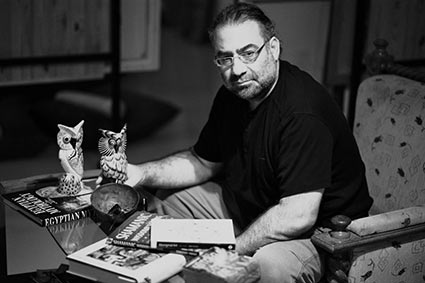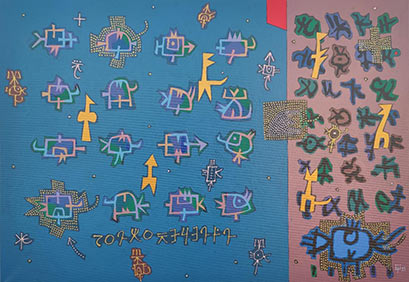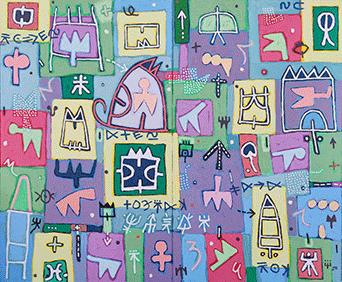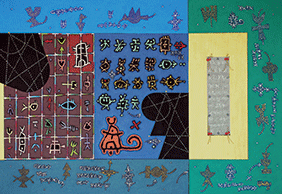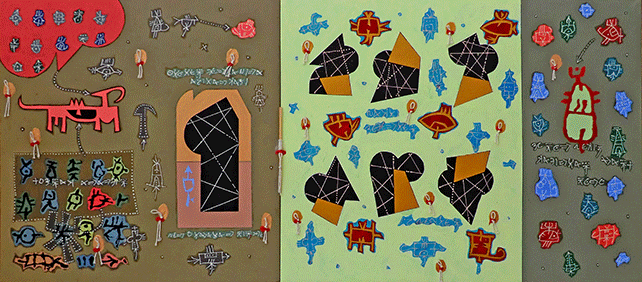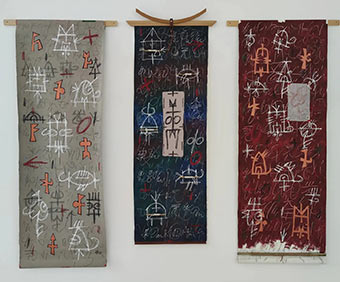VISUAL QUASI-ALPHABET FOR A PICTORIAL MULTI-ETHNICITY
Umit Inatci is in Italy, in the West. An exile once again, he has left the island of Cyprus in order to find asylum among the Umbrian walls that already in the past welcomed him. A citizen of peace, an exile like his pelagic ancestors, he brings us his roots and his absolute obstinacy in defending the thought of freedom that animates him.
A pictorial polyphony
Many years ago as an apprentice archeologist, I saw a tablet of bronze of Idalion in an old book that showed a document in Cypriot syllabic writing. Years later in a distant museum, I discovered the real document and, moved, I turned my gaze to the small object. The light was on it and the reflecting rays picked out elementary signs, an apparent simplification of archaic images that showed there was a relationship with Greek culture and with Middle East culture, but also with an expressivity present in contemporary artistic reality.
I am reminded of that tablet today when faced with the works of Umit Inatci, observing his search for the form of the sign, the shade of a hypothetical word, the definition of a space in terms of relation, the luminosity of a metal.
There is in fact present a derivative element in the work of this Cypriot artist, even if enriched by many other influences, by archaic documentation. The sign becomes a presence from its first timid and conscious appearance in canvases furrowed with traces in which images are set: herds, doves, carts, bombs and other elements with inferences both of a rustic memory and a contemporary iconography of war. There are also signs of a naturalistic origin linked to symbols, allegories and captions, turned into icons of an idea until they are categorized spatially and organized into a library of images a visual log of images.
The daily contact with art critic and curator Bruno Cora and the masters Nuvolo Ascani, Antonio Gatto and the direct knowledge of numerous artists, from Luciano Fabro to Michelangelo Pistoletto, from Mario and Marisa Merz to Enrico Castellani, Jannis Kounellis, Carla Accardi and many others during his years of training in Perugia stimulated a reflection on ways in which in art thought takes form and on the need for research into his own painting which he is creating over the years with constancy and with maturity. Figures are being transmuted into hieroglyphics and ideograms to the point where pictographic images are composed which increasingly tend towards abstraction. At the same time the elaboration of various ways of working with and using materials which are foreign to pictorial tradition - from the first timid but conscious 'engagement', justified by the need to experiment, to the point where why and how we act is discovered within one's own experience and tradition - suggest new possibilities, ways and synchronies with pigment and a vital essence that at times seems to flow with unstoppable impetus.
Research into the nature of the sign connects the works. It melts into a probable visual writing that conjugates within itself inferred elements from a large number of sources, from modern pictograms, scientific language, distant alphabets, elementary ideograms, from a deep archetypical heritage. The sign fills the pictorial space first in a gestural causality which is almost informal, then increasingly determined by elementary forms that can be traced back to the circle, the square and the rectangle in which Cartesian axes define the space in a grid, almost a sort of chessboard where signs, new letters and ideograms find their place as elements of a visual quasi-alphabet for a pictorial multi-ethnicity. In work after work these elements become increasingly icons of their own sign world from which the artist takes leave in order to conquer a greater elementary aspect in traces played with upon the canvas, the ephemeral limit between image and writing, refining it in the memory and causing the deepest experiences to rise again until writing takes place with images no longer linked to any kind of translation.
A game of chess between East and West
I've never been to Cyprus. I've often planned on going in order to swim in its sea and measure its past with my footsteps. My knowledge of it has come from books and those people who have talked at length to me of its beauty, its history and its Centuries old tragedy. Names and stories of the strenuous defense put up by the Giovanites against the Eastern powers come to mind, visits by kings resting between crusades, other subjugated kings and presumptuous sultans. Also of an ancient culture that conjugated the wisdom of two different fraternal worlds, one to the east and one to the west.
Inatci tries to create a sharing of one and the other, a relating of two worlds, a play of differences and similarities, in an ironical stroll along two paths, which over the centuries have crossed each other and then separated continually until the present wall of intolerance was created.
To suspend time in a repetition that evokes decorum without ever becoming it put gold as the place of epiphany in the image, give depth to elements by exalting their value and chromatic brilliance, continually and constantly find a way to abstraction without this being reconstituted by means of a narration with words that change themselves into taught gestural, tend to negation of the natural image and to its substitution with a non-writing, constitutes a masterly daily exercise of resistance to mimetic facility.
The size and proportions present even in the most gestural of works turn into a need to lay out pages within golden proportions, within compartments in which elements are related in a complexity within which the glance finds rest in subtle equilibriums. The lesson of the great Tifernian master, for so long observed from the first sacks to the large blacks, as well as that of Renaissance painting, are metabolized and resituated with intense visual results.
The carpet as mirror of everything
A legend, probably in part apocryphal, tells the story of an ambitious sultan -who, although in possession of a splendid and ancient carpet in the court of Bursa, wanted to engage the services of Egyptian artisans whose fame had reached him. He sent a ship to Cairo in order to engage a dozen. During the return journey a storm forced the ship to seek shelter in a port where it stayed for several weeks. The story then tells of how only eleven of the carpet makers left the port, which was on the island of Cyprus.
The grid becomes increasingly an organizing element in the equilibrium of the pictorial page and within it there is gradually composed a sort of a map of a territory that inclines towards the upper horizon, the probable profile of a landscape. From saturation to a rarefying of the image in a condition, which keeps in mind the spatial lesson of North American masters. The lower part leaps towards the observer while the upper part calmly becomes a monochrome background or an epigraphic image, emphasizing the outline, the margin that tends to decorate historically and define a problem concerning the frame. The grid, no longer regular and complete, often presents a break, a loss, one might say, of certainty and the emergence of a doubt. There is almost a break towards the edge, usually the upper edge, beyond which the signs disperse and float in color. The chessboard is no longer statically binding, but becomes a placement from which we make our own moves.
New geometries and new scratches intertwine and invade, consume adjacent spaces, relate to each other until they are reciprocally dissolved. Within the square a subtle play of references and responses suggest a path towards the eye: an arrow, an image sectioned into parts, a tonality of color towards another leads to a labyrinthine vision until there is a loss of orientation which is then regained in the work as a whole. Everything then returns to the surface in order to fall once again into the depths. The pictorial surface takes in and demonstrates to one's eyes the stratified and silent thought, refracts and consumes a sedimentation, which sets the basis for action. The various levels of pictorial, texture denote different work phases and they merge; the sign rests upon a background, a new arrangement surrounds the sign, a new sign underlines and marks again the preceding in a process of successive elaborations that become refined as the work develops, from the outset of a project, while taking into consideration an objective.
Unpronounceable words suspended in color.
Evagora, king of Salamis, twice offered his hospitality to the Greek Conon. His was a generous and troubled land, sold and abandoned, often betrayed (where otherwise could Iago plot?). A territory of strategic conquests from Sargon II, the Assyrian who subjected the seven kings to the Serenissima who ceded it to the Osmans of Selim II, up until the contemporary merchants of death who condition - if they do not actually manage from distant lands - the destiny of the island.
Umit Inatci's studies lead him back into the past, from the fauves to “surrealisme au service de la revolution”, and give free rein to dreamy colors representing the world differently. The fundamental colors dissolve in shades, which at times are powerful and at others delicate, which seem to overflow from the magic well of a modern dyer. They match each other, attract each other or reject each other in order to placate an impetus, in order to emphasize shininess or have an echo resonate. The browns accompany the blues, the violets the bright greens and reds with tones of yellow that grow until they become gold. The latter is an announcement of Byzantium but we do not know if it comes from the east or if it comes from, the west by means of central Italian medieval painting. It does not really matter so much from where but towards where. This announces the iconostasis, the opening, the portal beyond which all concealed. Chaos finds an apparent order and equilibrium and the golden threshold of the regal doors becomes an opening towards a greater spiritual dimension, a place of meditation.
Color captures light and space opens to make way for the mihrab, niches in mosques or prayer mats. Signs abandon even a similarity with writing in order to become the mark of a sound articulated in a whisper, in a shamanic song whose comprehension been denied to us. The eyes hear a word, which becomes a silent interior sound. However, at present it hinted only in a few recent works, perhaps the germ of future workings. The multitude of signs seems to squeeze into the forms that contain them. The abstract geometry changes into a memory tied to the thanatological tradition of a mausoleum, a boundary stone, a tumulus, a slab for a forgotten epigraph fixed into the land. Today the gold makes way for the powerful black that makes camp in a central position until it invades the entire pictorial surface: from gold to black, from black to the evoking of memory, nomination after death.
Paper, gauze, wood, wax, nets and metals: the different materials accumulate in order to conceal or exalt the painting. The interest is pictorial and they become new three-dimensional pigments. The point becomes a golden embossed scratch upon the surfaces, copper is placed upon the canvas almost as if to mark the hinges of an image whose weight it carries and to which it presents brilliancy. Embossed signs upon metal, backgrounds in gold and silver pigment upon canvas. Inversions and reflections, luminosity that is repeated from one picture to the next... The timid sign that surrounds the picture, the will to rediscover a measure of the image becomes a border, a material limit upon which oxidization marks the passage of time, draws the image into itself. Black as annihilation, as extreme limit reached after a sacrificial purification. The gold base reflects a darkened reality and becomes a picture that, tending towards supremacy, is cancelled out in Malevich-like black. The place of no return becomes a possibility for opening once again, a path towards new remedies in the future.
Painting moves towards lyricisms that are equal to the poetic word. The sound becomes brother to the movement of the brush, which finds its space in large colorful backgrounds.
Just like the cantore errante in Asia who Leopardi brought back to mind, it does not give up but longs for ‘wings to fly above the clouds/and number the stars one by one...’
Roma, 1997.
Umit Inatci, “Segni” 1995-1997”.



